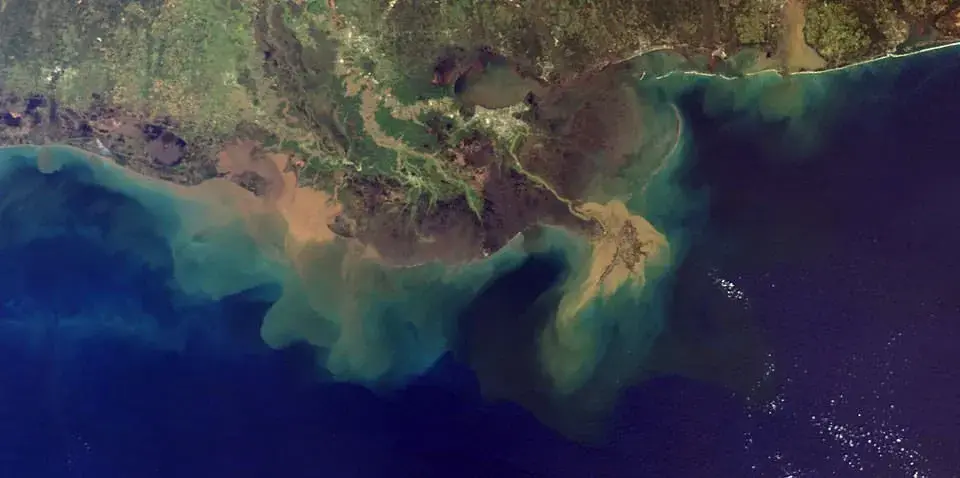Funded by a grant from the Pulitzer Center’s nationwide Connected Coastlines reporting initiative, The Price of Plenty series teamed up student journalists at the University of Florida and the University of Missouri to report on fertilizer. This series can be found on the Columbia Missourian and Florida's WUFT News websites.

Scientists have released their 2023 forecast for the so-called “dead zone” in the Gulf of Mexico — predicting it will be around 4,100 square miles this summer. That’s much bigger than last year, but still smaller than average.
The dead zone is a hypoxic area where low oxygen can kill fish and other marine life. It’s caused by excessive nutrient runoff, largely from fertilizer used on farm fields in the Midwest, which ends up in the Mississippi River and flows south to the Gulf.
The National Oceanic and Atmospheric Administration uses models and data from the U.S. Geological Survey to forecast the size of the dead zone each year. Data from river and stream gauges showed that nitrate and phosphorus discharges were below average in the Mississippi River and Atchafalaya River, which splits off in south Louisiana.

As a nonprofit journalism organization, we depend on your support to fund our nationwide Connected Coastlines climate reporting. Donate any amount today to become a Pulitzer Center Champion and receive exclusive benefits!
While some see this season’s forecast as good news, it is still well above the federal Hypoxia Task Force’s goal of shrinking the dead zone to 1,900 square miles or smaller by 2035. The area’s five-year average size is 4,280 square miles, more than double that target, and has trended mostly larger over time.
Don Scavia is an emeritus professor at the University of Michigan and leads one of several research teams partnering with the federal government on the annual forecast.
“Lack of a downward trend in the dead zone illustrates that current efforts to reduce those loads have not been effective,” he said. “Clearly, the federal and state agencies and Congress continue to prioritize industrial agriculture over water quality.”
A NOAA press release said the results were due to lower river flow rates. Despite lots of rain and flooding in the upper Midwest early this spring, discharge in May in the Mississippi and Atchafalaya rivers was about 33% below the long-term average.
Lauren Salvato, policy and program director at the Upper Mississippi River Basin Association, said she’s hopeful about the projections. “It’s certainly positive,” she said. “Our states are working hard and they want to meet their nutrient reduction goals.”
Most states within the Mississippi River basin have developed their own plans, in concert with the Hypoxia Task Force, to reduce nutrient runoff.
Salvato said new funding from the Bipartisan Infrastructure Law will help advance those goals. The task force has received $60 million for its action plan, $12 million per year for five years. Some states are using their portion of the funds to institute more sustainable farming practices, like cover crops, others are beefing up staffing, Salvato said.
“It’s monumental,” she said. “We’ve never had this program authorized, we’ve never had this kind of money put towards nutrient reduction strategies.”
However, she said the results of those new efforts won’t be measurable for years, maybe even decades.
NOAA’s press release about this year’s forecast touted it as being “below-average.” But Matt Rota, senior policy director at the environmental advocacy group Healthy Gulf, remained disappointed in the results and called NOAA’s description “misleading.”
“It’s twice the size of the goal,” he said. “It’s too big. It’s not smaller than anything.”
He said reducing the size of the dead zone will require either enforceable regulatory actions – rather than the opt-in programs on which most states have relied to reduce farm runoff – or billions of dollars of federal investment. The Bipartisan Infrastructure Law funding is a great start, Rota said, but it’s nowhere close to enough to solve the ongoing problem.
And he said dead zone forecasts aren’t just a numbers game. The livelihoods of thousands of people on the Gulf Coast are tied to fisheries, which are imperiled by the dead zone.
“It isn’t just about these numbers and these models — but how do we create a livable ecosystem?” he said.
NOAA and its research partners conduct a monitoring survey of the dead zone each summer, with results released in early August.











